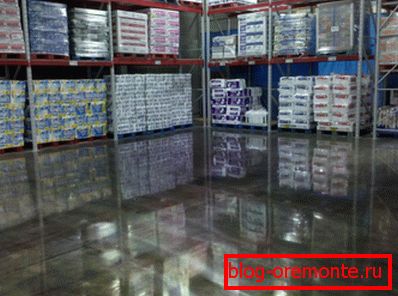Impregnation for a concrete floor: the main characteristics
In this article we will talk about how, why, and by what means the concrete floor is impregnated. The choice of the topic of the article is largely due to the growing popularity of concrete foundations of the floor, which are equally used in residential and public buildings as well as at industrial sites.

The reasons for carrying out hardening of concrete

Hardening of concrete floors is a mandatory procedure, which is commonly carried out in the construction of public and industrial buildings. In other words, the foundation of the floor requires hardening with special soils in the event that during operation it has an excessive mechanical load.
Properly made with your own hands hardening of concrete allows you to give the floor the following qualities:
- increased degree of wear resistance (resistance to mechanical loads, to the effects of excess moisture and to temperature changes);
- zero dust content on the floor surface and subsequent protection against dust formation, which is important if the reinforced concrete was cut with diamond circles;
- increase in operational resource;
- lower maintenance cost.
Important: This technology, among other benefits, allows you to quickly restore old and worn concrete floors.
Impregnation for concrete on the floor not only strengthens the top of the base, making it more wear-resistant and impact-resistant, but also contributes to a significant reduction in the time required for commissioning the object. This is an important advantage when it comes to modern industrial construction.
Applying high-quality impregnation, the base of the floor can be used for its intended purpose after 2 days.
Impregnation Classification

You do not know how to soak the concrete floor in the garage? In this case, consider the main types of impregnating soils on the market.
According to the composition, these materials are divided into two main categories: organic and inorganic modifications.
- Organic products can consist of acrylic, epoxy and polyurethane.. These materials act on the principle of filling concrete pores. As a result, dust removal and hardening of the concrete surface is ensured. Also, the surface receives additional hydrophobicity and resistance to chemicals.
Important: The most effective and functional polyurethane impregnation has proven itself, the price of which, by the way, is the most affordable.
- Inorganic compounds act on the principle of converting soluble compounds into insoluble. As a result, the surface of the base of the floor is strengthened and becomes more resistant to the effects of chemically aggressive media.
Important: Both those and other impregnating compositions are fundamentally different from additives, as they are applied to ready-made surfaces, and not integrated into the thickness of concrete.
In accordance with the characteristics of the application, the impregnating compositions are divided inheriting compositions:
- dust removal;
- hardening;
- water-repellent;
- universal.
However, modern developments of most brands are positioned precisely as universal ones and are suitable for performing a whole range of tasks.
Hardening means

The main characteristic of hardening impregnations is their full absorption into the surface layers of the base. As a result, a layer of concrete several centimeters deep acquires additional strength and resistance to mechanical stress.
The category of hardening means includes those materials that penetrate into the porous structure of the base, solidify there, forming a completely monolithic structure that provides additional strength to the whole structure as a whole.
Dust remover

Compounds intended for dedusting of concrete are used for processing vertical and horizontal surfaces in industrial and warehouse premises where additional finishing of walls and floors is not expected.
As a rule, dedusting agents perform a strengthening function, which is especially important if diamond holes were drilled in concrete before. In addition, such materials can be used to prepare concrete surfaces for subsequent painting.
Modern dedusting compositions do not have a coloring effect and in addition make the treated surface easier and more convenient in subsequent operation and maintenance.
In order to make the surface non-slip, before applying the impregnation, it should be wiped with quartz flour or fine-grained sand. Floors treated in this way are not only non-skid, but also abrasion resistant.
Water repellents

Water-repellent impregnations for concrete floors penetrate all micropores, fill them and harden. As a result, moisture, falling on the surface of the floor, can not penetrate into the pores.
However, the use of such impregnations protects the concrete not only from the effects of excessive moisture, but also from the formation of efflorescence due to salt and acid precipitation on the surface. Again, the treatment of these compounds makes the concrete more resistant to UV rays and the appearance of fungus, mold and other microorganisms.
Important: Due to the increased level of hydrophobicity of concrete, the degree of thermal conductivity of the walls and the floor is reduced.
Unlike traditional waterproofing, such as bituminous mastics or hydroglass insulation, the application instruction for penetrating waterproofing allows processing of construction objects not only from the outside, but also from the inside.
The most effective use is demonstrated by water-repellent two-component compositions used in the construction of pools and a number of other hydraulic structures.
Important: The effect of all the above means is a chemical reaction, and therefore the result of their use depends largely on the chemical composition of concrete.
Without reliable information on the chemical composition of concrete, impregnation is advisable to test on a small area of the finished coating. The tool can be easily purchased in the event that at the end of drying on the concrete whitish spots did not appear.
Conclusion
Now that you know what types of impregnating compositions are used to treat concrete surfaces, you will be able to choose the means that will correspond to the technical parameters and purpose of the construction object. You can find more useful information by watching the video in this article.